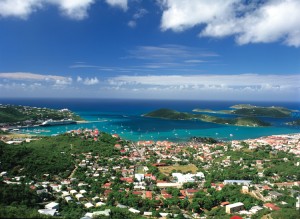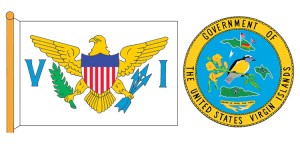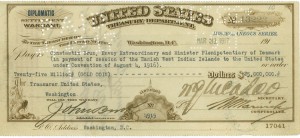U.S. Virgin Islands: 100 Years
Friday, March 31st, 2017March 31, 2017
Today, March 31, people in the U.S. Virgin Islands celebrate the 100th anniversary of Transfer Day—the day the territory became part of the United States. On March 31, 1917, the United States paid Denmark $25 million (equal to about $475 million today) for the Caribbean Island group, which was then known as the Danish West Indies. The U.S. Virgin Islands lie east of Puerto Rico and west of the British Virgin Islands. St. Croix, St. John, and St. Thomas islands, as well as many nearby islets, make up the U.S. Virgin Islands. In Charlotte Amalie, the territory’s capital and largest city, a number of events—including concerts, cultural exhibitions, festivals, and parades—began marking the centenary earlier in 2017. Transfer Day is an annual holiday in the U.S. Virgin Islands.

The city of Charlotte Amalie, on St. Thomas, is the capital of the U.S. Virgin Islands. Ocean liners, like the one shown in the distance, transport many tourists to the islands each year. Credit: © Steve Simonsen
The explorer Christopher Columbus sighted the Virgin Islands in 1493. Their fresh beauty and untouched appearance charmed him. Columbus named them the Virgin Islands in honor of Saint Ursula, a Christian martyr of the A.D. 300′s or 400′s. Columbus claimed the islands for Spain, but the Spanish did not settle there. About 1672, Denmark established a permanent settlement on St. Thomas. The Danes took possession of St. John in 1717 and bought St. Croix from France in 1733. Danish colonists developed a profitable sugar industry that supported the islands’ growth.

Click to view larger image
The U.S. Virgin Islands flag, at left, adopted in 1917, has a golden eagle with an olive branch in one claw and three arrows in the right claw on a white background. A yellow breast, the official bird of the islands, perched on the branch of a yellow cedar, the official tree, appears on the seal, at right, adopted in 1991. The three major islands of the U.S. Virgin Islands—St. Croix, St. John, and St. Thomas—are also represented on the seal. Credit: WORLD BOOK illustrations
The United States, wanting to secure a deepwater port in the Caribbean Sea, first tried to buy the Danish West Indies in 1867. U.S. Secretary of State William Seward—famous for the purchase of Alaska—led the effort to acquire the island group, but a number of events delayed the territorial transfer. Finally, in 1917, as the United States was about to enter World War I (1914-1918), the importance of purchasing the Danish West Indies outweighed other concerns. U.S. Secretary of State Robert Lansing concluded the $25-million deal with Danish Minister Constantin Brun. After the formal transfer at 4 o’clock in the afternoon on March 31, the Danish West Indies became the U.S. Virgin Islands. Today, the warm climate, beautiful scenery, and vibrant Caribbean culture make the islands a popular travel destination.

Click to view larger image
This $25-million dollar check was used to purchase the U.S. Virgin Islands from Denmark on March 31, 1917. Credit: National Archives
Like their neighbors in Puerto Rico, Virgin Islanders are U.S. citizens, but they cannot vote in presidential elections. Unlike in Puerto Rico (or anywhere else in the United States), however, cars in the Virgin Islands drive on the left side of the road—a fairly common thing in the Caribbean but a source of confusion to some visitors from the U.S. mainland. The Virgin Islands are home to a variety of wildlife, including native bats and a rare tree boa (an endangered species of snake). Lizards live throughout the islands, as do a variety of amphibians, birds, crustaceans, and insects. Speedy mongooses (brought to the islands to control rats and other pests) are a fairly common sight, as are wild deer, donkeys, and goats.


